fuse FIAT DOBLO 2009 2.G User Guide
[x] Cancel search | Manufacturer: FIAT, Model Year: 2009, Model line: DOBLO, Model: FIAT DOBLO 2009 2.GPages: 274, PDF Size: 6.6 MB
Page 170 of 274
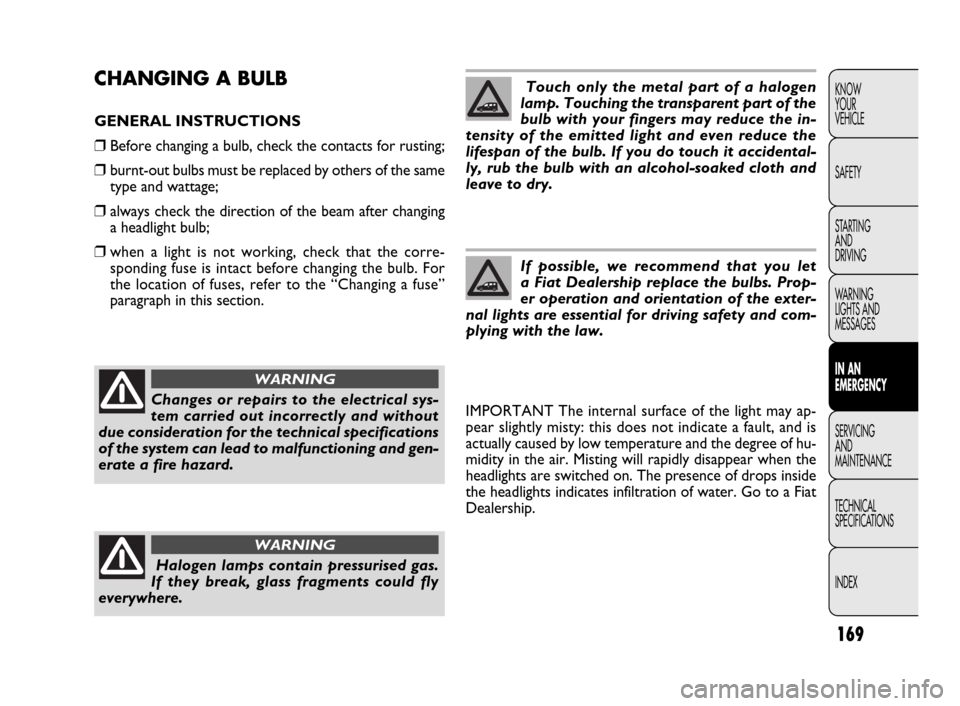
169
KNOW
YOUR
VEHICLE
SAFETY
STARTING
AND
DRIVING
WARNING
LIGHTS AND
MESSAGES
IN AN
EMERGENCY
SERVICING
AND
MAINTENANCE
TECHNICAL
SPECIFICATIONS
INDEXCHANGING A BULB
GENERAL INSTRUCTIONS
❒Before changing a bulb, check the contacts for rusting;
❒burnt-out bulbs must be replaced by others of the same
type and wattage;
❒always check the direction of the beam after changing
a headlight bulb;
❒when a light is not working, check that the corre-
sponding fuse is intact before changing the bulb. For
the location of fuses, refer to the “Changing a fuse”
paragraph in this section.
Changes or repairs to the electrical sys-
tem carried out incorrectly and without
due consideration for the technical specifications
of the system can lead to malfunctioning and gen-
erate a fire hazard.
WARNING
Halogen lamps contain pressurised gas.
If they break, glass fragments could fly
everywhere.
WARNING
Touch only the metal part of a halogen
lamp. Touching the transparent part of the
bulb with your fingers may reduce the in-
tensity of the emitted light and even reduce the
lifespan of the bulb. If you do touch it accidental-
ly, rub the bulb with an alcohol-soaked cloth and
leave to dry.
If possible, we recommend that you let
a Fiat Dealership replace the bulbs. Prop-
er operation and orientation of the exter-
nal lights are essential for driving safety and com-
plying with the law.
IMPORTANT The internal surface of the light may ap-
pear slightly misty: this does not indicate a fault, and is
actually caused by low temperature and the degree of hu-
midity in the air. Misting will rapidly disappear when the
headlights are switched on. The presence of drops inside
the headlights indicates infiltration of water. Go to a Fiat
Dealership.
Page 182 of 274
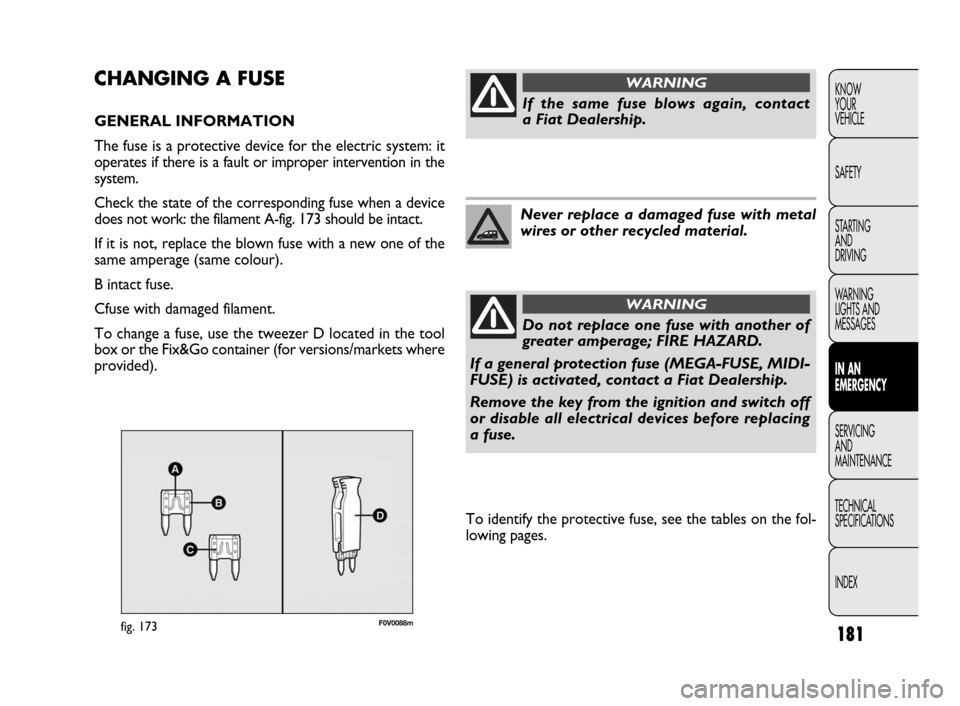
181
KNOW
YOUR
VEHICLE
SAFETY
STARTING
AND
DRIVING
WARNING
LIGHTS AND
MESSAGES
IN AN
EMERGENCY
SERVICING
AND
MAINTENANCE
TECHNICAL
SPECIFICATIONS
INDEX
F0V0088mfig. 173
CHANGING A FUSE
GENERAL INFORMATION
The fuse is a protective device for the electric system: it
operates if there is a fault or improper intervention in the
system.
Check the state of the corresponding fuse when a device
does not work: the filament A-fig. 173 should be intact.
If it is not, replace the blown fuse with a new one of the
same amperage (same colour).
B intact fuse.
Cfuse with damaged filament.
To change a fuse, use the tweezer D located in the tool
box or the Fix&Go container (for versions/markets where
provided).
If the same fuse blows again, contact
a Fiat Dealership.
WARNING
Never replace a damaged fuse with metal
wires or other recycled material.
Do not replace one fuse with another of
greater amperage; FIRE HAZARD.
If a general protection fuse (MEGA-FUSE, MIDI-
FUSE) is activated, contact a Fiat Dealership.
Remove the key from the ignition and switch off
or disable all electrical devices before replacing
a fuse.
WARNING
To identify the protective fuse, see the tables on the fol-
lowing pages.
Page 183 of 274
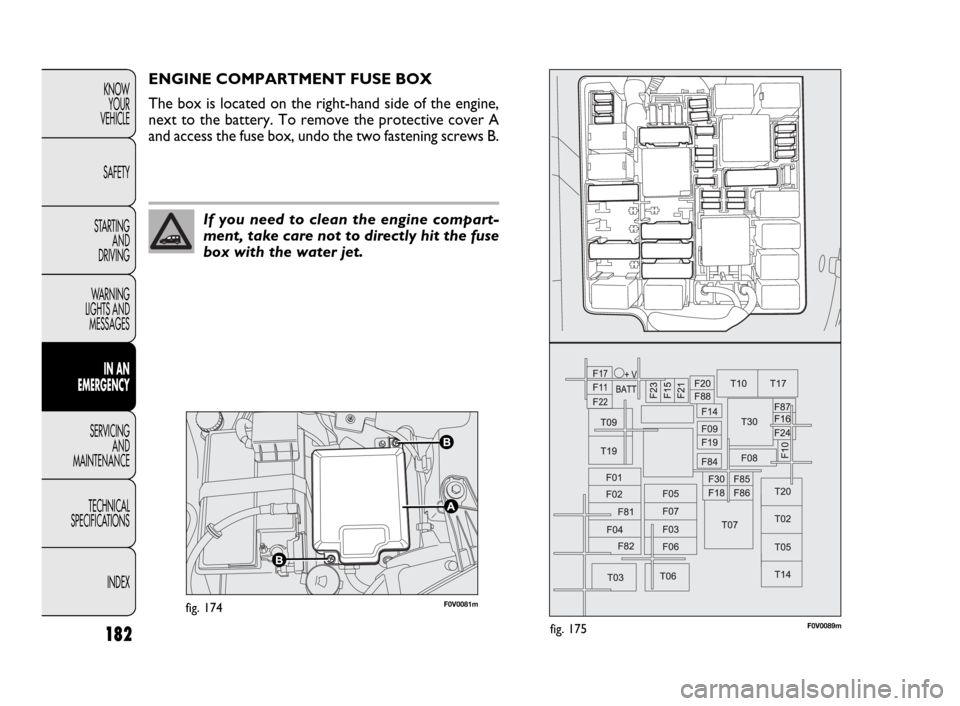
182
KNOW
YOUR
VEHICLE
SAFETY
STARTING
AND
DRIVING
WARNING
LIGHTS AND
MESSAGES
IN AN
EMERGENCY
SERVICING
AND
MAINTENANCE
TECHNICAL
SPECIFICATIONS
INDEX
F0V0081mfig. 174
F0V0089mfig. 175
ENGINE COMPARTMENT FUSE BOX
The box is located on the right-hand side of the engine,
next to the battery. To remove the protective cover A
and access the fuse box, undo the two fastening screws B.
If you need to clean the engine compart-
ment, take care not to directly hit the fuse
box with the water jet.
Page 184 of 274
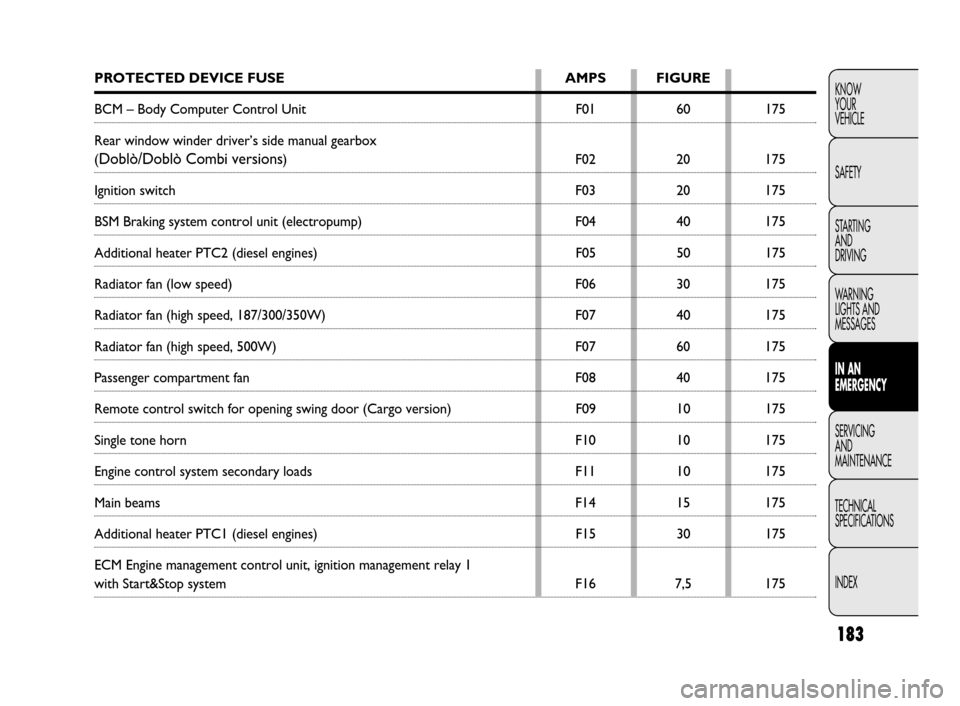
183
KNOW
YOUR
VEHICLE
SAFETY
STARTING
AND
DRIVING
WARNING
LIGHTS AND
MESSAGES
IN AN
EMERGENCY
SERVICING
AND
MAINTENANCE
TECHNICAL
SPECIFICATIONS
INDEXPROTECTED DEVICE FUSE AMPS FIGURE
BCM – Body Computer Control Unit F01 60 175
Rear window winder driver’s side manual gearbox
(Doblò/Doblò Combi versions) F02 20 175
Ignition switch F03 20 175
BSM Braking system control unit (electropump) F04 40 175
Additional heater PTC2 (diesel engines) F05 50 175
Radiator fan (low speed) F06 30 175
Radiator fan (high speed, 187/300/350W) F07 40 175
Radiator fan (high speed, 500W) F07 60 175
Passenger compartment fan F08 40 175
Remote control switch for opening swing door (Cargo version) F09 10 175
Single tone horn F10 10 175
Engine control system secondary loads F11 10 175
Main beams F14 15 175
Additional heater PTC1 (diesel engines) F15 30 175
ECM Engine management control unit, ignition management relay 1
with Start&Stop system F16 7,5 175
Page 185 of 274
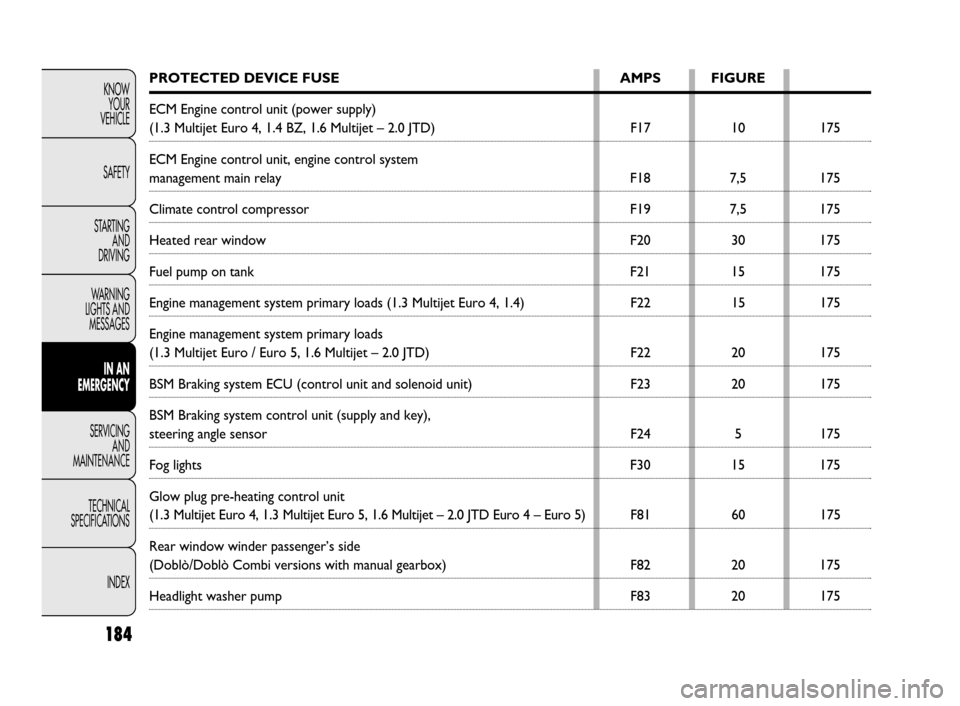
184
KNOW
YOUR
VEHICLE
SAFETY
STARTING
AND
DRIVING
WARNING
LIGHTS AND
MESSAGES
IN AN
EMERGENCY
SERVICING
AND
MAINTENANCE
TECHNICAL
SPECIFICATIONS
INDEXPROTECTED DEVICE FUSE AMPS FIGURE
ECM Engine control unit (power supply)
(1.3 Multijet Euro 4, 1.4 BZ, 1.6 Multijet – 2.0 JTD) F17 10 175
ECM Engine control unit, engine control system
management main relay F18 7,5 175
Climate control compressor F19 7,5 175
Heated rear window F20 30 175
Fuel pump on tank F21 15 175
Engine management system primary loads (1.3 Multijet Euro 4, 1.4) F22 15 175
Engine management system primary loads
(1.3 Multijet Euro / Euro 5, 1.6 Multijet – 2.0 JTD) F22 20 175
BSM Braking system ECU (control unit and solenoid unit) F23 20 175
BSM Braking system control unit (supply and key),
steering angle sensor F24 5 175
Fog lights F30 15 175
Glow plug pre-heating control unit
(1.3 Multijet Euro 4, 1.3 Multijet Euro 5, 1.6 Multijet – 2.0 JTD Euro 4 – Euro 5) F81 60 175
Rear window winder passenger’s side
(Doblò/Doblò Combi versions with manual gearbox) F82 20 175
Headlight washer pump F83 20 175
Page 186 of 274

185
KNOW
YOUR
VEHICLE
SAFETY
STARTING
AND
DRIVING
WARNING
LIGHTS AND
MESSAGES
IN AN
EMERGENCY
SERVICING
AND
MAINTENANCE
TECHNICAL
SPECIFICATIONS
INDEXPROTECTED DEVICE FUSE AMPS FIGURE
Passenger compartment socket, rear socket F85 30 175
Cigarette lighter, heated seats F86 30 175
IBS Battery charge status sensor for Start&Stop system F87 5 175
Wing mirror defrosters F88 7,5 175
Page 187 of 274
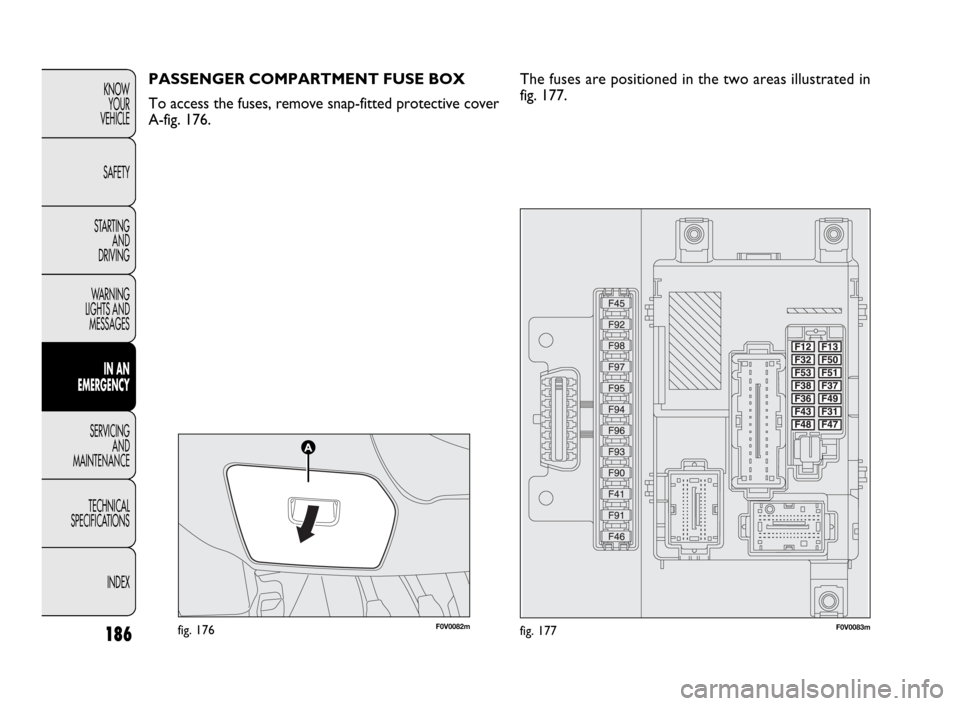
186
KNOW
YOUR
VEHICLE
SAFETY
STARTING
AND
DRIVING
WARNING
LIGHTS AND
MESSAGES
IN AN
EMERGENCY
SERVICING
AND
MAINTENANCE
TECHNICAL
SPECIFICATIONS
INDEX
F0V0082mfig. 176F0V0083mfig. 177
PASSENGER COMPARTMENT FUSE BOX
To access the fuses, remove snap-fitted protective cover
A-fig. 176.The fuses are positioned in the two areas illustrated in
fig. 177.
Page 188 of 274

187
KNOW
YOUR
VEHICLE
SAFETY
STARTING
AND
DRIVING
WARNING
LIGHTS AND
MESSAGES
IN AN
EMERGENCY
SERVICING
AND
MAINTENANCE
TECHNICAL
SPECIFICATIONS
INDEXPROTECTED DEVICE FUSE AMPS FIGURE
Right low beamF12 7,5 177
Front courtesy light, rear courtesy light, lights on sun visors,
door clearance lights, boot light F32 7,5 177
Instrument panel F53 5 177
Door lock/unlock motors, dead lock actuator motors,
tailgate lock motor F38 20 177
Power + battery for EOBD diagnostic socket, automatic climate control unit,
alarm siren, sound system, convergence control unit, tyre pressure detector
control unitF36 10 177
Windscreen/rear window washer pump F43 15 177
Window winder motor for front door passenger side F48 20 177
Left low beam, headlight corrector F13 7,5 177
Airbag ECUF50 7,5 177
Int. power for brake pedal switch,
clutch pedal switch, interior heater,
convergence control unit, sound system set-up F51 7,5 177
Int. power for instrument panel, brake pedal switch,
third brake light F37 5 177
Int. power for control panel lights, parking control unit,
tyre pressure detector control unit, electric door mirror motor,
rain sensor, electric top control unit, My-port infotainment socket F49 5 177
Int. power for engine fusebox relay coils and
body computer relay coils F31 5 177
Window winder motor for front door driver’s side F47 20 177
Rear socketF94 15 177
Cigarette lighter/Passenger compartment socket F95 15 177
Cigarette lighter/Passenger compartment socket F96 15 177
Heated driver seat F97 10 177
Heated passenger seat F98 10 177
Page 200 of 274
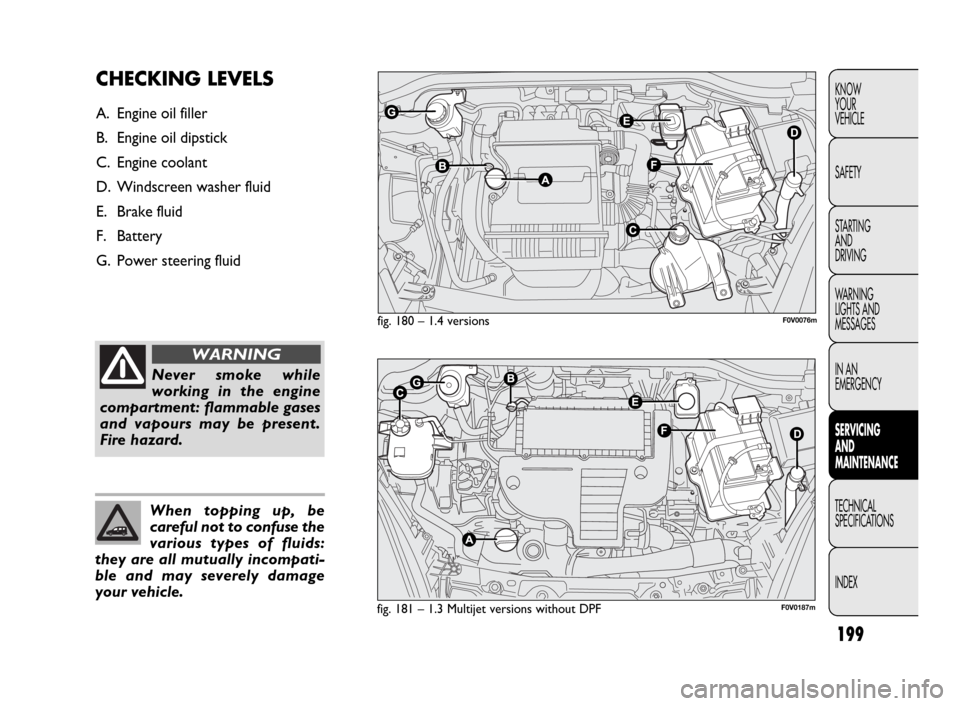
199
KNOW
YOUR
VEHICLE
SAFETY
STARTING
AND
DRIVING
WARNING
LIGHTS AND
MESSAGES
IN AN
EMERGENCY
SERVICING
AND
MAINTENANCE
TECHNICAL
SPECIFICATIONS
INDEX
fig. 180 – 1.4 versions
fig. 181 – 1.3 Multijet versions without DPFF0V0076m
F0V0187m
CHECKING LEVELS
A. Engine oil filler
B. Engine oil dipstick
C. Engine coolant
D. Windscreen washer fluid
E. Brake fluid
F. Battery
G. Power steering fluid
Never smoke while
working in the engine
compartment: flammable gases
and vapours may be present.
Fire hazard.
WARNING
When topping up, be
careful not to confuse the
various types of fluids:
they are all mutually incompati-
ble and may severely damage
your vehicle.
Page 217 of 274
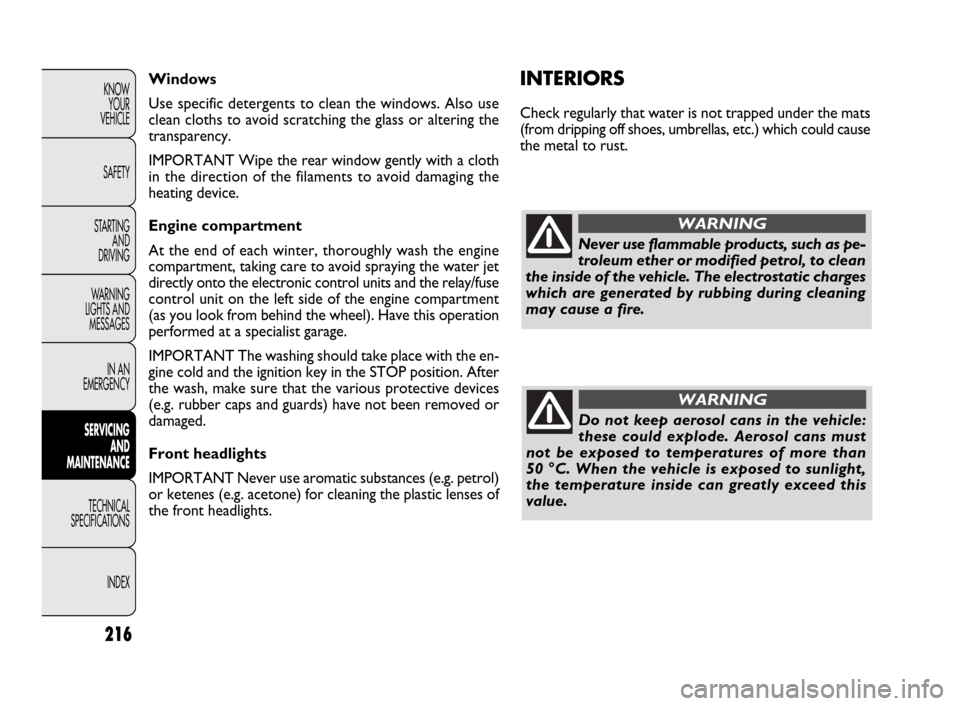
216
KNOW
YOUR
VEHICLE
SAFETY
STARTING
AND
DRIVING
WARNING
LIGHTS AND
MESSAGES
IN AN
EMERGENCY
SERVICING
AND
MAINTENANCE
TECHNICAL
SPECIFICATIONS
INDEXINTERIORS
Check regularly that water is not trapped under the mats
(from dripping off shoes, umbrellas, etc.) which could cause
the metal to rust. Windows
Use specific detergents to clean the windows. Also use
clean cloths to avoid scratching the glass or altering the
transparency.
IMPORTANT Wipe the rear window gently with a cloth
in the direction of the filaments to avoid damaging the
heating device.
Engine compartment
At the end of each winter, thoroughly wash the engine
compartment, taking care to avoid spraying the water jet
directly onto the electronic control units and the relay/fuse
control unit on the left side of the engine compartment
(as you look from behind the wheel). Have this operation
performed at a specialist garage.
IMPORTANT The washing should take place with the en-
gine cold and the ignition key in the STOP position. After
the wash, make sure that the various protective devices
(e.g. rubber caps and guards) have not been removed or
damaged.
Front headlights
IMPORTANT Never use aromatic substances (e.g. petrol)
or ketenes (e.g. acetone) for cleaning the plastic lenses of
the front headlights.
Never use flammable products, such as pe-
troleum ether or modified petrol, to clean
the inside of the vehicle. The electrostatic charges
which are generated by rubbing during cleaning
may cause a fire.
WARNING
Do not keep aerosol cans in the vehicle:
these could explode. Aerosol cans must
not be exposed to temperatures of more than
50 °C. When the vehicle is exposed to sunlight,
the temperature inside can greatly exceed this
value.
WARNING